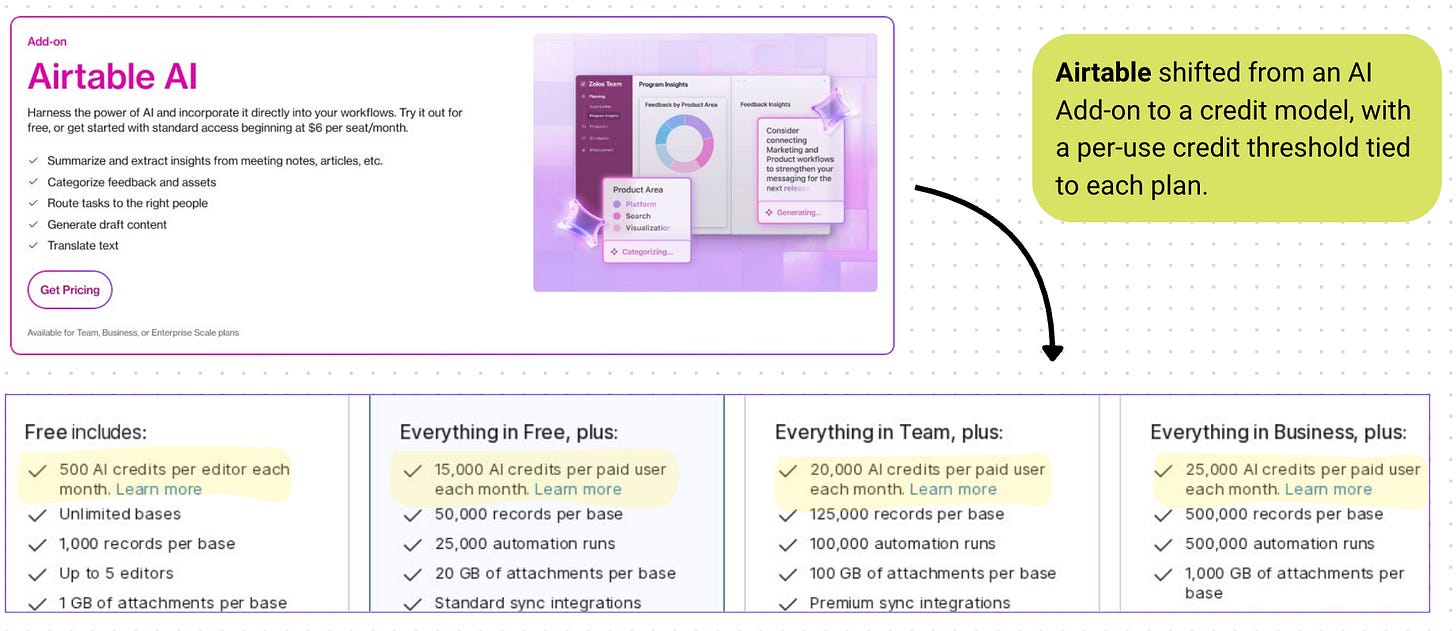Airtable’s Shift from AI Add-On to Credits
Plus: Aha!’s Modular Pricing Meets Project Management.
Welcome back to Good Better Best!
Today we’re breaking down recent pricing changes from Airtable and Aha!.
Airtable shifted from an AI add-on to a credit model
Aha! introduced a new project management module
AI pricing and modular packaging models have come up in multiple conversations recently, so it was fun digging into examples of each. Let’s get to it.
Your pricing isn’t too simple. It’s too rigid.
Most SaaS teams obsess over packaging. But in the Value Era, static plans and seat-based pricing aren’t the bottleneck—your billing infrastructure is.
This blog post from Metronome breaks down why modern pricing requires modular systems that support hybrid models, real-time usage data, and fast iteration. If your monetization can’t keep up with your product velocity, read this.
Airtable’s Shift from AI Add-On to Credits
Last month, Airtable shifted from an AI add-on to a credit model, with per-user credit thresholds for each plan. Sharing my thoughts in no particular order below:
This shift fits Airtable specifically and has become a popular play for productivity apps broadly (Miro has a per-user credit threshold, Monday has a per-account credit threshold).
Previously, prospective buyers had to contact sales to get access to Airtable AI. The Airtable AI landing page suggests they originally piloted the AI product with Enterprise customers. There’s a good chance they had plans to add AI credits to tiers all along, but used a limited rollout to get feedback from heavy users to better understand usage thresholds.
While the credit limit is tied to each user, the credits are actually pooled for shared use across all users. This pooling is user friendly, and allows power users to keep using Airtable AI even if they exceed their personal credit limit. It also makes for a stronger case for an upgrade if a customer is routinely exceeding the credit limit for their account.
The reason this approach is so promising for these productivity apps is because of its potential as an expansion accelerant. Customers may hit the AI credit limit on their account, but even if they don’t, there’s a chance their AI usage could cause them to use the product more and hit another usage threshold that triggers an upgrade (in Airtable’s case, automation runs, records, or storage limits).
Airtable breaks AI functionality into 3 buckets: AI Fields & Assistant, Cobuilder, and AI Admin Controls. All plans get some access to AI Fields & Assistant and Cobuilder, but Admin Controls are restricted to Business and Enterprise plans. This is another smart move, as it could drive upgrades from heavy Team plan accounts strictly for the ability to have more control over how their team uses AI.
Importantly, credits expire monthly, and do not rollover. This makes sense given credits are a usage threshold and not the primary metric that Airtable charges for. With a product like Clay, where credits are the primary pricing metric, offering flexibility (credit rollovers, top-ups) is more necessary.
Overall, this feels like a sharp move. If anyone knows a member of the Airtable team that was involved in this rollout, I’d love to talk to them and learn more.
Aha! Introduced a Project Management Product
Recently, I’ve been getting asked a lot about modular pricing. If you’re looking for an example, Aha! fits the bill. They already offered a suite of modules for product management and productivity, including:
Aha! Roadmaps: product strategy, goals, feature planning, timelines.
Aha! Discovery: idea and research management
Aha! Ideas: idea collection, crowdsourcing, prioritization.
Aha! Whiteboards: collaborative docs and whiteboards.
Aha! Knowledge: knowledge base for internal and external docs.
Aha! Develop: agile development tool for engineers.
Their newest release is Aha! Teamwork, a project management app that fits seamlessly with the rest of their suite. Shortly after visiting the pricing page, I realized I had entered what can only be described as a vortex of cross-selling and upselling.
For Teamwork alone, Aha! offers two plans, Essentials and Advanced, and a free trial. Further down the page, they promote an upgrade to Aha! Roadmaps. This process is repeated in some form for every product, resulting in 8 different pricing pages, 15 plans, and an intoxicating number of product combinations.
As a salesperson, I love the cross-sell opportunities, but as a marketer I have a hard time seeing a coherent story across the products and plans. Beyond that, I’m curious what billing platform they’re using to manage this SKU chaos.
Scrolling the pricing page, I was reminded of Okta’s shift to a tiered model earlier this year. Tiers offer faster decision-making, shorter sales-cycles, and the benefits of bundle economics (Aha! does some of this already). Importantly, a la carte and tiered models are not mutually exclusive. Okta leads with tiers, but still offers custom agreements with an itemized catalog of a la carte options.
Aha!’s current approach offers ultimate optionality. On the positive side, customers can choose whatever they want and have full flexibility for how they want to engage. I’d argue a more prescriptive option could serve as a worthy complement.
How we can help when you’re ready
PricingSaaS Community: Join the free PricingSaaS Community to get quick answers from experts, real-time pricing data, and access to exclusive events.
PricingSaaS Index: Check out the PricingSaaS Index to track competitors, scroll pricing histories, and create a swipe file of pricing pages for inspiration.
Free Advisory Session: Need a sounding board? Book a 30-minute session. No sales pitch. We’ll provide honest feedback and steer you in the right direction.





